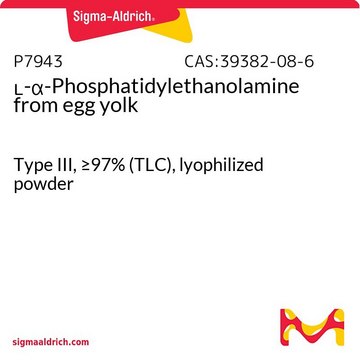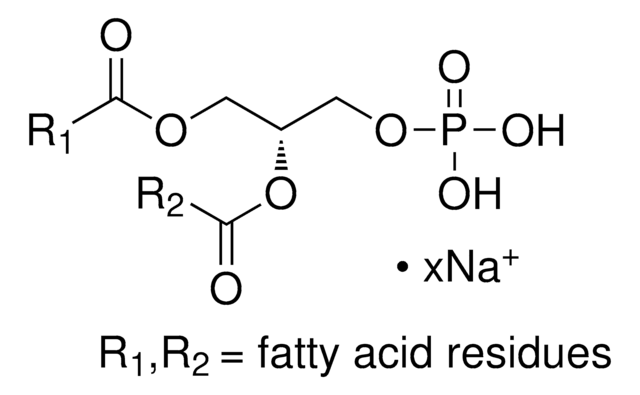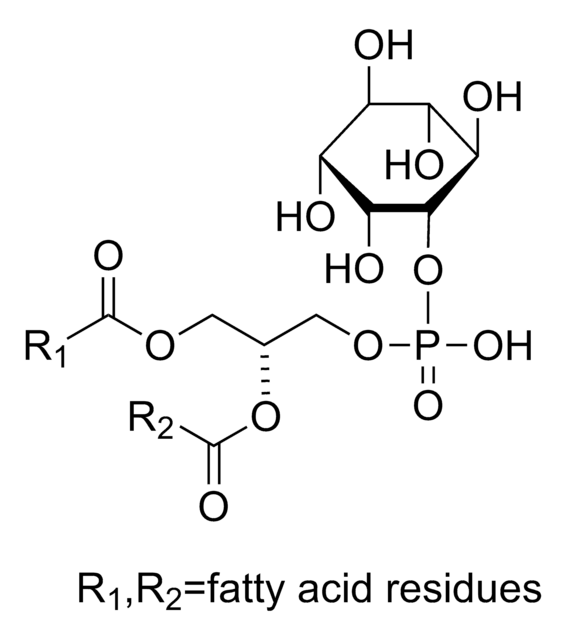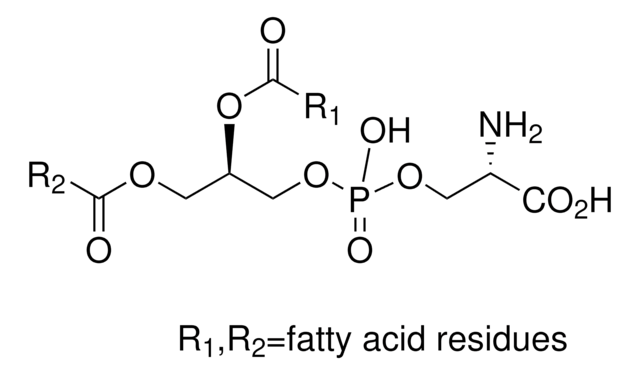P7693
3-sn-Phosphatidylethanolamine from bovine brain
Type I, ≥98% (TLC), lyophilized powder
Synonym(s):
1,2-Diacyl-sn-glycero-3-phosphoethanolamine, L-α-Cephalin, L-α-Phosphatidylethanolamine from bovine brain
Sign Into View Organizational & Contract Pricing
All Photos(1)
About This Item
Recommended Products
type
Type I
Quality Level
Assay
≥98% (TLC)
form
lyophilized powder
lipid type
phosphoglycerides
storage temp.
−20°C
SMILES string
[P](=O)([O-])(OCC[N+H3])OCC(OC(=O)C)COC(=O)C
InChI
1S/C9H18NO8P/c1-7(11)15-5-9(18-8(2)12)6-17-19(13,14)16-4-3-10/h9H,3-6,10H2,1-2H3,(H,13,14)
InChI key
CFWRDBDJAOHXSH-UHFFFAOYSA-N
Looking for similar products? Visit Product Comparison Guide
Biochem/physiol Actions
The major structural phospholipid in brain, comprising 20-25% of total lipid; primarily localized to gray matter.
Packaging
Packaged under Argon.
Caution
Purity when prepared is 98-99%. Solutions exposed to room temperature can decompose 0.3-0.5% per day.
Choose from one of the most recent versions:
Already Own This Product?
Find documentation for the products that you have recently purchased in the Document Library.
Customers Also Viewed
Yanfeng Zhang et al.
Biochemical and biophysical research communications, 404(1), 407-412 (2010-12-07)
The botulinum neurotoxins (BoNTs) produced by different strains of the bacterium Clostridium botulinum are responsible for the disease botulism and include a group of immunologically distinct serotypes (A, B, E, and F) that are considered to be the most lethal
Kelly Varga et al.
Journal of neurochemistry, 152(1), 48-60 (2019-10-07)
Phosphatidylserine (PS), a negatively charged phospholipid present predominantly at the inner leaflet of the plasma membrane, has been widely implicated in many cellular processes including membrane trafficking. Along this line, PS has been demonstrated to be important for endocytosis, however
Shane P Herbert et al.
The Journal of biological chemistry, 284(9), 5784-5796 (2009-01-03)
Release of endothelial cells from contact-inhibition and cell cycle re-entry is required for the induction of new blood vessel formation by angiogenesis. Using a combination of chemical inhibition, loss of function, and gain of function approaches, we demonstrate that endothelial
Zachary J Smith et al.
Journal of extracellular vesicles, 4, 28533-28533 (2015-12-10)
Current analysis of exosomes focuses primarily on bulk analysis, where exosome-to-exosome variability cannot be assessed. In this study, we used Raman spectroscopy to study the chemical composition of single exosomes. We measured spectra of individual exosomes from 8 cell lines.
Ryozo Azuma et al.
International journal of systematic and evolutionary microbiology, 59(Pt 6), 1469-1473 (2009-06-09)
A Gram-positive, short diphtheroid-shaped organism was isolated from a sow's placenta of an abortion. This novel isolate, strain Murakami(T), was examined physiologically, chemotaxonomically and phylogenetically. Cells had an irregular V-shaped or palisade arrangement. Colonies appeared translucent on TMVL agar. Cells
Our team of scientists has experience in all areas of research including Life Science, Material Science, Chemical Synthesis, Chromatography, Analytical and many others.
Contact Technical Service










